How to Make Your Own Hot Sauce – Non-Fermented
It is so easy to make your own hot sauce. If you love hot sauce and have tons of hot peppers – try this recipe!

Also Read: Homemade Cayenne Pepper & Hot Pepper Flakes, Pickled Hot Peppers, Bacon Wrapped Jalapeno Poppers
With this easy non-fermented hot sauce, you chop, cook, blend, strain and bottle your hot sauce. You’ll be done within an hour or less. The result is a thin, smooth Louisiana style hot sauce similar to Frank’s Red Hot Sauce or Sriracha. Make it as hot as you like!
Difference Between Fermented and Non-Fermented Hot Sauce
Fermented hot sauce requires a longer process and can take 7 days to several weeks. Basically, you mix hot peppers and a salt brine and then wait for naturally occurring yeast and bacteria to transform the peppers. It’s relatively easy, it just takes time. There are many different ways to make fermented hot sauce which may or may not use commercial vinegar at some point. As a result, the taste profile can vary greatly, but most agree that fermented hot sauce has a little more complex taste.
Fermented food also has the benefit of providing healthy probiotics, but unless you’re using spoonfuls of sauce daily, I don’t think that’s a major advantage when it comes to hot sauce.
I’ve made fermented hot sauce several times and haven’t found the flavour of the end product to be worth the extra time. I would rather get the added complexity by experimenting by using different ingredients in my quick cooking sauce – adding cumin, onions, sweet peppers, fruit, etc.

What Kind of Peppers to Use
Use whatever hot peppers you have easy access to and that you enjoy the most. Better yet, use a combination of peppers to build complexity of flavour. You can even replace some of the hot peppers with sweet peppers. Personally, I love a blend of red jalapeno, serrano and cayenne peppers – the result is hot, but not crazy hot!
If you have green hot peppers – use those and make a green sauce!
PRO TIP: For the best looking sauce, stick to all green or all red peppers when making a batch. If you mix green and red peppers you’ll end up with a less attractive brown coloured sauce.
Here are some hot peppers for hot sauce lovers to consider:
Ancho Peppers (1,000 to 2,000 SHU): Ancho peppers have a mild to moderate heat. They have a deep, rich, slightly sweet flavour and are used in some Mexican-style hot sauces.
Chipotle Peppers (2,500 to 8,000 SHU): Chipotles are smoke-dried jalapeños. They have a smoky, earthy flavour and are often used in hot sauces with a smoky profile.
Jalapeño Peppers (2,500 to 8,000 SHU): Jalapeños have a moderate level of heat and a slightly grassy or earthy flavour. Jalapeño-based hot sauces are often milder and suitable for a broader range of palates.
Serrano Peppers (10,000 to 23,000 SHU): Serranos have a bright, crisp flavour and are commonly used in Mexican hot sauces.
Cayenne Peppers (30,000 to 50,000 SHU): Cayenne peppers are medium-spicy, with a slightly sweet and smoky flavour and are often used in Louisiana-style hot sauces like Tabasco.
Tabasco Peppers (30,000 to 50,000 SHU): Tabasco peppers are used to make Tabasco sauce, a well-known hot sauce brand. They have a balanced heat with a slightly tangy, vinegary flavour.
Thai Bird’s Eye Chilies (50,000 to 100,000 SHU): These small but fiery chilies are commonly used in Thai and Southeast Asian hot sauces.
Habanero Peppers (100,000 to 350,000 SHU): These small, lantern-shaped peppers are known for their intense heat and their fruity flavour. They are a popular choice for hot sauces and can add a tropical twist to the sauce.
Scotch Bonnet Peppers (100,000 to 350,000 SHU): Scotch bonnets are quite hot. They have a distinct fruity flavour and are a key ingredient in many Caribbean hot sauces and jerk sauces.
Ghost Peppers (Bhut Jolokia) (855,000 to 1,041,427 SHU): Ghost peppers are extremely hot. They have a smoky, slightly sweet taste and are used in super-hot hot sauces, requiring caution when handling them.
Carolina Reaper (1,641,183 to 2,200,000 SHU): One of the world’s hottest pepper, with a fruity, fiery flavour. Used sparingly in some of the hottest hot sauces.
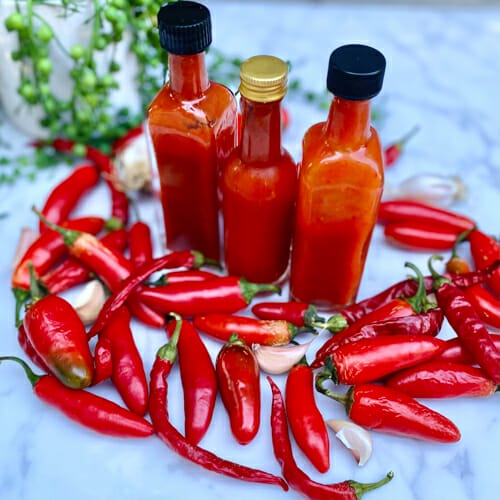
Adjusting the Heat in Your Hot Sauce
Want to increase or decrease how hot your hot sauce is? Try one or a combination of these strategies to spice things up or down.
- Use a combination of sweet and hot peppers. Keep the overall amount in the recipe the same, but add in some red bell peppers for a milder sauce.
- Check the Scoville chart to see how many scoville heat units (SHU) your peppers have. The SHU measures approximately how much capsaicin is in a variety of peppers – although this can vary with every batch.
- Remove the ribs and seeds for less heat. The highest concentration of capsaicin (the compound that makes hot peppers hot) is in the white ribs or membranes inside peppers. Because the seeds cling to these membranes, they’re often hot too, but the heat is really in those white ribs! You can choose whether to keep them or remove them.
- Adding the onions builds flavour and helps tame the heat just a little.
- Add a little sweetness. While it won’t change the actual heat level, it makes our taste buds think there’s less heat.
- Add a little more acid. More vinegar, wine, lemon or lime juice will help.
- Add a little tomato paste.
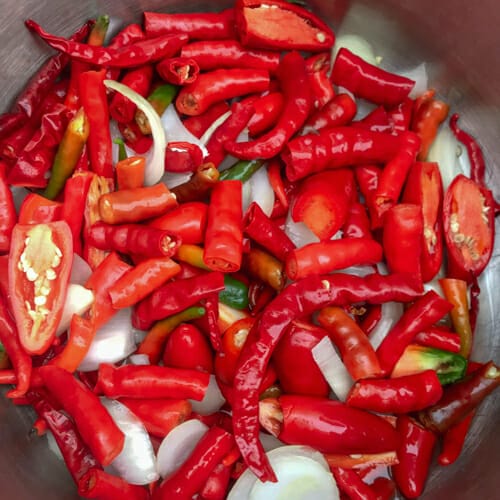
Recipe for Homemade Non-Fermented Hot Sauce
Homemade Hot Sauce
Ingredients
- 10 oz red hot peppers (cayenne, jalapeno, serrano, fresno, etc) 4 cups
- 3-5 cloves fresh garlic, roughly chopped
- 1/2 cup roughly chopped onion
- 1 tsp salt
- 1 1/2 cups apple cider vinegar or white vinegar
- 1/2 cup water
- 2 tsp honey (optional)
Instructions
- Wear gloves when handling this many hot peppers! Wash and remove stems from peppers. Chop roughly into small pieces (Kitchen scissors work great for slender peppers). Keep or remove seeds and white ribs depending on how much heat you want. The more you leave in, the hotter your sauce will be.
- Combine peppers, garlic and onion with vinegar and water in pot and simmer for 20 minutes until peppers have softened. Remove from heat and let cool for 15 minutes.
- Transfer to blender or use immersion blender to puree the mix. Caution, the hot pepper fumes will be strong, open the blender lid away from you.
- Taste the puree and decide if you'd like more salt or a little honey to round out the flavour. Have a little cheese nearby, just in case.
- Strain out seeds using fine sieve or cheesecloth. If sauce is too thick, add a little more vinegar or water.
- Pour into sterilized jars or bottles (pint/2cup/500ml). (Wash then boil in water for 10 minutes.)
- Seal with lid and keep refrigerated for up to 6 months. Flavour will be best after letting it age for at least 2 weeks.
- Makes about 2 cups or 100 teaspoon sized servings!
Video
Notes
Nutrition Facts (per serving)

To get a nice smooth sauce, we strain the cooked sauce using a fine sieve. If the sauce is a little too thick, I add a little more vinegar to make it runnier.
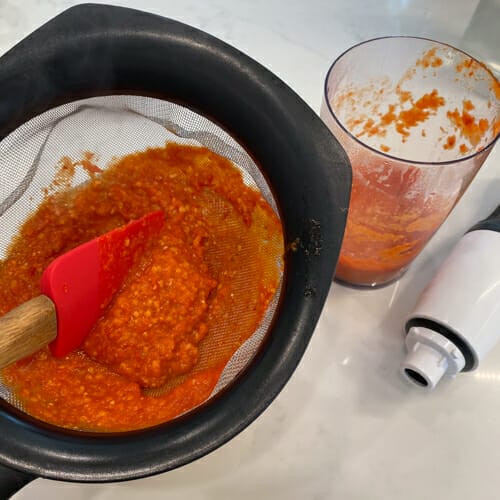
The leftover pulp, I spread on a dehydrator tray and dehydrate. When it’s thoroughly dry, I put it into a grinder and turn it into a powder – we call it Sriracha powder and use it just like cayenne pepper.
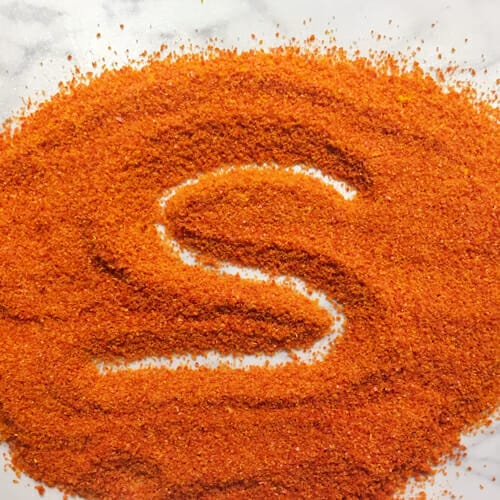
Label for Homemade Red Hot Sauce
Homemade hot sauce makes a great gift – affordable, fun and very much appreciated by food lovers! I made a red and green sauce one Christmas that I gave as hostess gifts and to my entire family.
Look Here for More Gifts From the Kitchen!
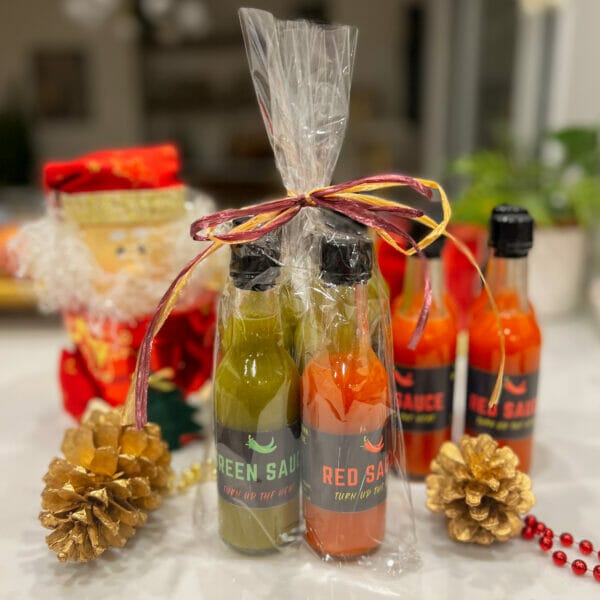
I went all out and ordered “5 oz glass woozy bottles” from Uline (the official name) along with lids and shrink wrap for the tops (I used my hair dryer to shrink the plastic). None of that was necessary, but it was fun to make them look “pro”.
I also created a 4″x 2″ label to stick onto the jar. Caution: When printed at home, on label paper, it’s not very waterproof, but the presentation is nice! You’ll need to check around for something waterproof if you wish.

Here is a pdf version for you to download if you’d like. Red Sauce Label pdf.
More Ways to Use Hot Peppers
If you have a bounty of hot peppers, here are some other ways we like using them.
- Homemade Cayenne Pepper & Hot Pepper Flakes
- Pickled Hot Peppers
- Bacon Wrapped Jalapeno Poppers
- Salsa
- Hot Pepper Jelly
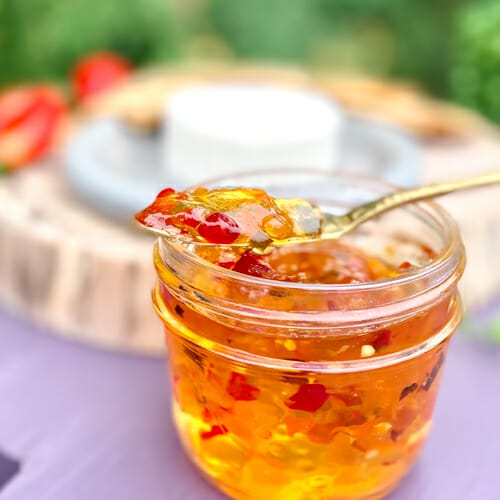
Do you have a favourite hot pepper? How do you prefer to use them? Let me know your favourites either down below or on Instagram @getgettys or Facebook @GettyStewart.HomeEconomist.
Getty Stewart is a Professional Home Economist, speaker, frequent media guest and writer dedicated to using and enjoying seasonal foods. She is the author of several recipe books on enjoying and preserving fruit, a mom and veggie gardener. Sign up to get articles by Getty delivered to your inbox. You’ll get recipes, practical tips and great food information like this.


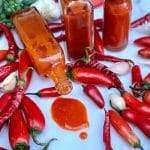
hi. i was looking at a couple hot sauces in my fridge and had a couple bottle of hot sauce. one stated fermente and the other not. after reading your article i had an aha moment. i am going to fry or bake some wings- tis the season- lol and can’t wait to be a hot sauce ‘officionato’—lol
Yahoo! So glad I can help – thanks for sharing.
how much is 10 ounces I have 8 qts
You only need 4 cups. 8 qts equals 32 cups, 10 oz is 4 cups.
how much is 10 oz I have an 8 qt basket of peppers
10 oz is about 4 cups of peppers, so you have more than enough considering 1 qt=4cups. Hope this helps.
I would love bell pepper plants or seed.
where could I get these.
thanks
You should be able to get them at any greenhouse or garden center. Good luck.